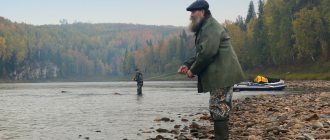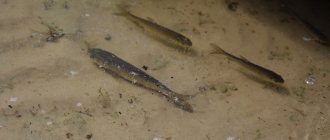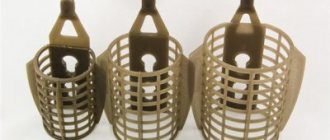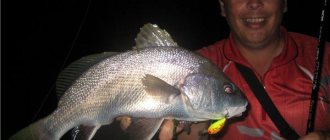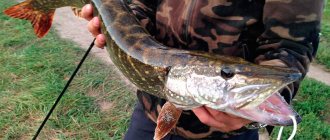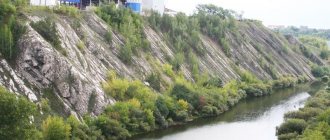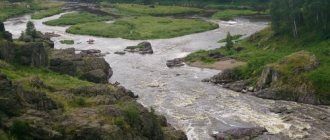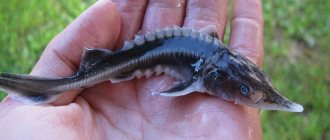Information
Author: Wiki Catcher
Date: Jun 29, 2017
Category: Siberian Federal District
Rating: no rating
Characteristics
Federal District:
Siberian Federal District
Region:
Republic of Tyva, Republic of Khakassia, Krasnoyarsk Territory
Type of reservoir:
rivers
Fish:
verkhovka, common minnow, dace, ruff, crucian carp, bream, tench, burbot, perch, gudgeon, roach, sculpin, sterlet, catfish, trout, grayling, spined loach, pike, ide, char, lenok, nelma, omul, taimen , vendace, pink salmon, peled, sturgeon, lamprey, tugun
Types of fishing:
float fishing, bottom fishing, spinning, fly fishing, live bait fishing, winter types of fishing, other types of fishing
Length:
3487 km
Width:
0.1-50 km
Maximum depth:
25 m
Pool:
2580000 km²
GIMS:
Ministry of Emergency Situations for the Krasnoyarsk Territory, Ministry of Emergency Situations for the Republic of Khakassia, Ministry of Emergency Situations for the Republic of Tyva
Status:
free
The Yenisei is a river in Siberia, one of the largest rivers in the world and Russia. It flows into the Kara Sea of the Arctic Ocean.
Geographical information
One of the largest rivers in the world: the length of the river from the confluence of the Big Yenisei and the Small Yenisei is 3487 km (with the Small Yenisei - 4287 km, from the sources of the Big Yenisei - 4092 (4123) km). In terms of basin area (2,580 thousand km²), the Yenisei ranks 2nd among the rivers of Russia and Eurasia (after the Ob) and 7th among the rivers of the world. The Yenisei basin is characterized by sharp asymmetry: its right-bank part is 5.6 times larger than the left bank.
The Yenisei is a natural border between Western and Eastern Siberia. The left bank of the Yenisei ends the great West Siberian Plain, and the right bank represents the kingdom of mountain taiga. From the Sayan Mountains to the Arctic Ocean, the Yenisei passes through all the climatic zones of Siberia. Camels live in its upper reaches, and polar bears live in its lower reaches.
The Yenisei itself begins from the city of Kyzyl, where the Big Yenisei and the Small Yenisei merge. The height of the source is 619.5 m above sea level. Over the first 188 km, the Yenisei flows under the name Upper Yenisei (Ulug-Khem), within the northern side of the Tuva Basin in the west, the river breaks into branches, the channel is replete with rifts, the width ranges from 100 to 650 m; depths on the reaches are 4-12 m, on the rifts no more than 1 m. From Shagonar, the Sayano-Shushenskoye reservoir begins, formed by the dam of the Sayano-Shushenskoye hydroelectric station. Having accepted the Khemchik River on the left, the Yenisei turns north and for 290 km breaks through the Western Sayan Mountains and the Minusinsk Basin. Below the dam of the Sayano-Shushenskaya hydroelectric power station, the small Mainskoye reservoir begins, ending with the Mainskaya hydroelectric power station.
After the confluence of the left tributary - the Abakan River - the Krasnoyarsk reservoir begins (length 360 km), formed by the dam of the Krasnoyarsk hydroelectric station, located near the city of Divnogorsk, at the intersection of the Yenisei spurs of the Eastern Sayan. The width of the valley here is 5 km, the channel is more than 500 m. Between Krasnoyarsk and the mouth of the Angara, the Yenisei valley expands again, the river loses its mountainous character, but there are still underwater ridges in the channel - a continuation of the spurs of the Yenisei Ridge. Below the confluence of the Angara, the character of the valley and bed of the Yenisei changes dramatically. The right bank remains mountainous, the left bank becomes low and floodplain.
The width of the Yenisei valley at the mouth of the Lower Tunguska is about 40 km, at Dudinka and Ust-Port up to 150 km, the riverbed is 2.5-5 km; the minimum depths of the entire lower Yenisei range from 5 to 8.5 m. Below Dudinka, the prevailing depths are 20-25 m, the channel is divided into branches, the islands reach a length of 20 km. From the mouth of the Kureyka River, where tidal fluctuations in level are already felt, the mouth section of the Yenisei begins. The site of Cape Sopochnaya Karga is taken as the mouth section. Below the village of Ust-Port the Yenisei delta itself begins. The Brekhov Islands divide the channel of the Yenisei into many channels, of which four main branches stand out: the Okhotsk Yenisei, the Kamenny Yenisei, the Big Yenisei and the Small Yenisei; the total width of the channel here is 50 km. Below, the Yenisei flows in one channel, in the “throat”, forming the Yenisei Bay of the Kara Sea.
The Yenisei belongs to the type of rivers of mixed feeding with a predominance of snow. The share of the latter is slightly less than 50%, rain - 36-38%, underground in the upper reaches up to 16%, and decreases towards the lower reaches. Freezing of the Yenisei begins in the lower reaches (beginning of October). The Yenisei is characterized by intensive formation of inland ice and autumn ice drift. Freeze-up occurs in the lower reaches from the end of October, in mid-November in the middle reaches and near Krasnoyarsk, and in late November - December in the mountainous part. In some areas, thick ice deposits appear in the riverbed.
Most of the Yenisei is characterized by extended spring floods and summer floods; in winter there is a sharp reduction in flow (but levels drop slowly due to the development of floods). The upper reaches are characterized by extended spring-summer floods. The flood on the Yenisei begins in May, sometimes in April, on the middle Yenisei somewhat earlier than on the upper Yenisei, on the lower Yenisei in mid-May - early June. Spring ice drift is accompanied by congestion.
In terms of flow (624 km³), the Yenisei ranks first among Russian rivers. The average annual water flow at the mouth is 19,800 m³/s, the maximum flow at Igarka is 154,000 m³/s.
The list of the most significant tributaries of the Yenisei includes the following rivers: on the left - Khemchik, Kantegir, Abakan, Kem, Kas, Sym, Dubches, Elogui, Turukhan, Malaya Kheta, Bolshaya Kheta, Tanama, Gryaznukha; on the right - Us, Kebezh, Tuba, Syda, Sisim, Mana, Kan, Angara, Big Pete, Podkamennaya Tunguska, Bakhta, Lower Tunguska, Kureyka, Khantaika, Dudinka. In total, about 500 more or less significant rivers flow into the Yenisei, and their total length is more than 300 thousand kilometers.
Cities on the river, location downstream: Kyzyl, Shagonar, Sayanogorsk, Minusinsk, Abakan, Divnogorsk, Krasnoyarsk, Sosnovoborsk, Zheleznogorsk, Lesosibirsk, Yeniseisk, Igarka, Dudinka.
Feed the sturgeon
– You won’t surprise a real Siberian with grayling. Are the times of the king fish sturgeon and sterlet really gone?
– Not so long ago the beautiful Angara was called the sterlet river. What is Angara like today? This is a system of lake-like basins that are connected by bridges. The cascade of hydroelectric power stations has radically changed the inflow of the Yenisei. There is no more Angara, only basins... Sturgeon has not been found in it since 1970, sterlet, taimen, lenok, and whitefish are pushed into the tributaries. And the influx in its food supply cannot support a large fish population. Therefore there is little of it. Roach, perch and pike live in the Angara. And this in the river, which was called sterlet! The Krasnoyarsk reservoir also changed the habitats of the Yenisei basin, the temperature, and the entire structure of the ichthyocenosis. There was sturgeon and sterlet. Do you understand? There were a lot of dace and grayling. But the basis of the fishery was salmon and sturgeon. And after the formation of the Krasnoyarsk reservoir, the volumes decreased significantly. But again, it’s not a matter of quantity. The quality of fish in the Krasnoyarsk reservoir is low. There are three species there - perch, roach and bream. They kill the entire catch. The remaining species of the legendary valuable Yenisei fish are absent. Almost no whitefish. Only single ones are found in estuaries and tributaries. Sometimes only one or two specimens of sterlet are found per year. They are small in size and are called “pencils” by fishermen. There is still no sturgeon, although sturgeon have been stocked in the Yenisei for twenty years. The Beloyarsk fish factory dumped. This species is dying, the sea does not correspond to its living conditions. It lacks pebbly soil and fast currents. In ancient times, in the 19th century, sturgeon accounted for up to 40% of the catch. And there were a lot of sterlet. The sturgeon has been slowly disappearing for several decades. After the war he was literally exterminated. Then, in different years, its fishing was banned. It is currently prohibited from being caught. But we have already lost the sturgeon. And not only Yenisei. Let me again cite our neighbors as an example. The Ob sturgeon spawns above the Novosibirsk dam. The hydroelectric power station blocked the sturgeon's path. For two years the fish fought against the dam, came to it and fought, trying to get to the spawning site. Two years passed, two generations of sturgeon simply died out. But the Ob sturgeon adapted and found spawning grounds in the Chulym and Keti - tributaries of the Ob.
– Is the ban an effective measure? Does the protection of biological resources help restore populations of valuable fish species or are other measures needed?
– The number of fish is limited by the amount of food. If the stock is undermined and then the catch is limited, it is not a fact that the stock will be restored. Here are the “good people” who offer to throw food into the Yenisei for the king fish. A sturgeon is not a pig; it does not eat feed. By the way, Norwegian trout eat artificial food, so it is very cheap. Many Western countries no longer buy it: the quality of the meat is much lower, and the content of omega-3 fatty acids is low. By the way, the richest source of fatty acids is Atlantic herring. But let's return to the sturgeon. Since 1998, there has been a ban on its fishing in the Krasnoyarsk Territory. But the population is not recovering. Without artificial fish farming, restoration of the Yenisei sturgeon is impossible.
The damage is caused by poaching. In terms of the degree of negative impact, it is sometimes placed even ahead of industrial. Fish protection - 108 people for the entire region. Plus Khakassia. Evenkia is guarded by three people. The head and two fisheries inspectors for all rivers. Taimyr – seven people. Obviously, it is impossible to track every poacher. There are fines for violating fish farming laws. The amounts can amount to hundreds of millions of rubles per year. These funds could be used for fish farming, but they go to the federal budget.
Bridges and crossings
From the source to the mouth on the river there are the following crossings: City Bridge in Kyzyl, Transport Bridge in Kyzyl - bypass road of the M54 "Yenisei" highway, Pedestrian-road bridge in Cheryomushki, Bratsky Bridge connecting Abakan and Minusinsk, Bratsky Bridge near the village of Zeleny Bor, The railway-automobile bridge near the village of Zeleny Bor, the Automobile bridge near the city of Divnogorsk, the Fourth automobile bridge across the Yenisei in Krasnoyarsk - built from Kopylov Street to Sverdlovskaya Street, the Railway Bridge in Krasnoyarsk, the Communal Bridge in Krasnoyarsk, the Oktyabrsky Bridge in Krasnoyarsk, the Korkinsky Bridge, and also a bridge over the Yenisei on the transport bypass of Krasnoyarsk - a bypass road of the federal highway M53 "Baikal".
Bream is not a friend to sturgeon
– Will not only low-value fish remain in our rivers and lakes in the future as they are more adapted to survival?
– As I already said, for centuries the species composition of fish in the Yenisei has not changed. The number and distribution zones have changed. Some other species were added that came to us as a result of acclimatization. For example, pink salmon. It was stocked in the Kara and White Seas. She did not go to the rivers of the Kola Peninsula, but went to Norway. They call it Russian salmon and thank Russia. And it got to the Yenisei, single specimens are found. The carp came to the Krasnoyarsk reservoir. They call it wild carp. There are individual individuals weighing up to 20 kg. Verkhovka, verkhovka - a small fish has taken root with us. Predator, eats everything. It needs to be fought, as it eats up the food supply of more valuable fish. The bream worries us. It left the reservoir through the downstream of the hydroelectric power station, spread to Dudinka along the Yenisei, and creates fishing accumulations. Badly! After all, he eats the same food as the sterlet. The sterlet population will decline. In addition, it leaves the ruff and minnow hungry. And they feed on taimen and lenok. Low-value bream eats everyone. A scourge to fight, an invader.
Finally, another misfortune was discovered quite recently. My colleague from the department, Ivan Zuev, caught a rotan, a “firebrand,” in the area of the Bugach pond. This is a native of the Far Eastern rivers; we need to find out how it came to us. A non-commercial species, the head occupies a third of the body, and is unusually voracious. Harmful look. It can compete with valuable fish species.
– Anatoly Alekseevich, can we help the Yenisei?
– Let them call me “old regime”, but it is not in our power to change anything radically. Except how to engage in artificial fish breeding.
DOSSIER
Anatoly Alekseevich VYSHEGORODTSEV
Born in the Komi Autonomous Soviet Socialist Republic in 1941. In 1968 he graduated from Tomsk University with a degree in ichthyology. Lives and works in Krasnoyarsk since 1974. Candidate of Biological Sciences, Associate Professor of the Department of Terrestrial and Aquatic Ecosystems, Institute of Fundamental Biology and Biotechnology, Siberian Federal University. Candidate's dissertation “Whitefish of the river basin” Yuribey (Gydan Peninsula). Disciplines taught: • biological resources and aquaculture, • general ichthyology, • lake fish farming.
№ 18 / 608
Related links:
Today at 16:16
, a Krasnoyarsk resident knocked down the balcony door in his ex-wife’s apartment to see the children
Today at 16:15 Students of a technical school in Krasnoyarsk were detained for extorting money from first-year students
Today at 15:29 Two-time Olympic champion Elena Isinbaeva is expected in the Krasnoyarsk Territory
Today at 15:24 more than 200 people were evacuated from the Ivan Yarygin Sports Palace
What kind of fish is found in Siberian rivers?
Even more interesting facts!
Siberian rivers are home to a large variety of fish species.
The richest waters in terms of the presence of various fish are the waters of Western Siberia. The most prominent are the Ob and its channels. There are also a lot of fish in the rivers Yenisei, Tom, Amur, Aya, Lena, Kia, Mras-su, Ters, Uryup.
Grayling
- a fish from the salmon family. It is most often found in the rivers of Siberia. This species is especially common in northern rivers. Grayling's habitat is clean water bodies and cold rivers. It feeds on insects, algae, mollusks and larvae. This species is omnivorous.
Muksun
- one of the most valuable northern fish. This commercial species belongs to the whitefish family. This species is found in almost any major Siberian river. Muksun is valued for its good taste and nutritional value. There are regions where fishing for muksun is prohibited.
In the Ob and Yenisei rivers there are a large number of fish such as whitefish
. It belongs to the whitefish family. The whitefish lives in fresh or semi-fresh water bodies. Belonging to the carp family, ide lives in reservoirs in different countries of Europe and Siberia. This fish is omnivorous. Most of it is in rivers, lakes and ponds. This species is not found in cold and mountain rivers.
Nelma live in Siberian rivers
. This is the largest representative of the whitefish family. The most common nelma is in the river basins of the Arctic Ocean and the river expanses of Siberia. This species has good taste. According to this indicator, it has no equal among other fish species living in Siberian rivers. But fishing for nelma is prohibited in many areas of Siberia.
Omul also belongs to the whitefish family
. Most often this species is found on Lake Baikal.
Pyzhyan lives in the rivers of Siberia
. This species feeds on mollusks, insects and larvae.
Tugun is found in northern rivers
. Most often it lives in Lena and Yenisei.
Lenok lives in fresh waters and reservoirs
. It belongs to the salmon family. Most of this fish is found in rifts and mountain rivers.
Taimen
belongs to the salmon family and
is listed in the Red Book
. Its production is prohibited in many reservoirs. This predator lives in cold and fresh waters.
Among other types of fish that are found in Siberian rivers is pike. dace. burbot, common Chukuchan, chebak.
